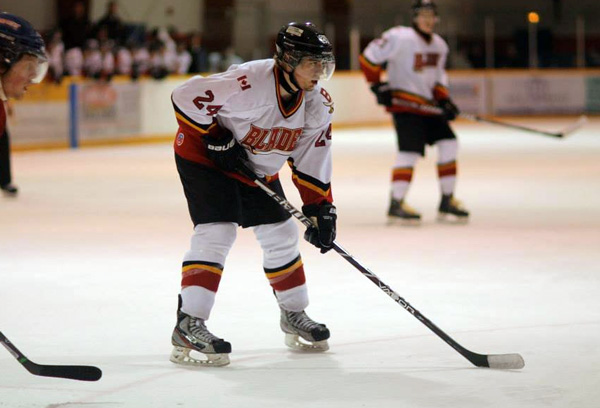Is It Time To Re-Think Junior C’s Overage Rule?

Drew Marlatt was the Great Lakes Jr. C rookie of the year as a 16-year-old, and was third on his Blenheim Blades in scoring. Could the Blades have benefitted from another underage player like Marlatt? – Photo by Kelsey Vermeersch/ CKSN.ca
So, which option is it? Should Junior C be a league where players can develop to move on to Junior B or A, the OHL, and beyond? Or is it a league for 20 and 21 year olds to have fun and play competitive hockey.
Currently, Junior C teams are allowed one 16-year-old “underager,” and they’re also allowed to carry three 21-year-old “overagers.”
At a different time, Junior C teams could carry several underage players, which would make sense in a developmental league. The OHA changed underage rules to encourage players to stay in their home centres and play ‘AAA’ or minor hockey.
One could argue however, that very few, if any, players billet or live away from home to compete at the Junior C level. Most are locally grown players. As well, in Chatham-Kent, without a Major Midget ‘AAA’ program, our players are forced to travel to London or Windsor to remain competitive, or to take a step back developmentally by moving to their home centres.
Junior B teams are allowed two underage players, and as Junior C is a developmental league for B, it would only make sense that Junior C would be a place where more young players, not less, would be allowed to play and develop.
This season, Chatham-Kent Cyclones Minor Midget graduates Drew Marlatt (Blenheim Blades), Dede Cato (Dresden Kings), Mike Zottl (Wallaceburg Lakers), James McEwan (Chatham Maroons), and Brendan Johnston (Chatham Maroons) ate up the local underage cards, while other players, who would have been assets to local Junior hockey teams including Trent Fox (Ridley College), Jake Reed (Windsor Jr. Spitfires AAA), and Hunter Burk (Hill Academy), were forced to leave Chatham-Kent to find competitive hockey. Others remained in local minor hockey, such as Chatham’s Austin Bentley, who played a handful of games in Blenheim as an affiliate.
I think it’s time the OHA re-thought the 16-year-old rule, again, at least at the Junior C level. It doesn’t make sense to have Junior C teams loaded with 19-, 20-, and 21-year-olds when our local 16-year-olds can’t find a competitive league, despite having the talent to be difference makers in Junior C.
Of the 23 players on the Blenheim Blades roster in 2013-2014, 11 were 19 or older. The Dresden Kings, 13 of 23. The Wallaceburg Lakers, 8 of 22.
It’s ludicrous to think these young players can’t get the ice time or develop in Junior C, or for that matter, Junior B, if card restrictions were loosened.
Don’t get me wrong, there is a place for these olders players. They keep the league competitive and help the younger players improve, but it might be time to consider tweaking this rule. In my opinion, each Junior C team should be allowed three 16-year-old underagers, and keep the status quo on 21-year-old overagers.
What do you think?



Ian, I hope this does gain some legs. For sure something needs to change.
Also just another note which does not make sense, a 16 year old player, on a Jr. C team, cannot even be called up to play for a Jr. B team when a kid a year younger, from a Minot Midget team can.
The plan for “Home Town Hockey” was meant well but for our area is a failure.
I just want to clarify a couple things,
1) The 16 year old allotment for JR C is a league averaging, if there are 10 teams in the league then there can only be 10 16 year olds if a team does not sign a 16 year old then another team can apply for that allotment and have 2 signed 16 year olds which is the max at the moment, the 16 year old ruling is not controlled by the OHA its in the Hockey Canada CDM (Canadian Development Model) and the OHA has done a TON to have it changed or altered and have come a long way in trying to increase 16 year olds at this level
2) Jr C teams are allowed 4 21 year olds on their roster as long as they played the previous season with said team.